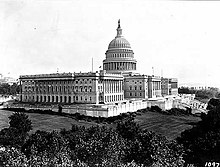Fifty-eighth Congress
| 58th United States Congress | |
|---|---|
|
57th ←
→ 59th
|
|

United States Capitol (1906)
|
|
| March 4, 1903 – March 4, 1905 | |
| Senate President | Vacant |
| Senate Pres. pro tem | William P. Frye (R) |
| House Speaker | Joseph G. Cannon (R) |
| Members | 90 senators 386 representatives 5 non-voting members |
| Senate Majority | Republican |
| House Majority | Republican |
| Sessions | |
|
Special: March 5, 1903 – March 19, 1903 1st: November 9, 1903 – December 7, 1903 2nd: December 7, 1903 – April 28, 1904 3rd: December 5, 1904 – March 3, 1905 |
|
The Fifty-eighth United States Congress was a meeting of the legislative branch of the United States federal government, composed of the United States Senate and the United States House of Representatives. It met in Washington, DC from March 4, 1903, to March 4, 1905, during the third and fourth years of Theodore Roosevelt's presidency. The apportionment of seats in the House of Representatives was based on the Twelfth Census of the United States in 1900. Both chambers had a Republican majority.
TOTAL members: 386
This list is arranged by chamber, then by state. Senators are listed in order of seniority, and Representatives are listed by district.
At this time, Senators were elected by the state legislatures every two years, with one-third beginning new six-year terms with each Congress. Preceding the names in the list below are Senate class numbers, which indicate the cycle of their election, In this Congress, Class 1 meant their term ended with this Congress, requiring reelection in 1904; Class 2 meant their term began in the last Congress, requiring reelection in 1906; and Class 3 meant their term began in this Congress, requiring reelection in 1908.
The names of members of the House of Representatives elected statewide on the general ticket or otherwise at-large, are preceded by an "At-large," and the names of those elected from districts, whether plural or single member, are preceded by their district numbers.
Many of the congressional district numbers are linked to articles describing the district itself. Since the boundaries of the districts have changed often and substantially, the linked article may only describe the district as it exists today, and not as it was at the time of this Congress.
(9 Democrats)
(7 Democrats)
(5-3 Republican)
(2-1 Republican)
(5 Republicans)
(1 Democrat)
(3 Democrats)
(11 Democrats)
(1 Republican)
(17-8 Republican)
(9-4 Republican)
...
Wikipedia
